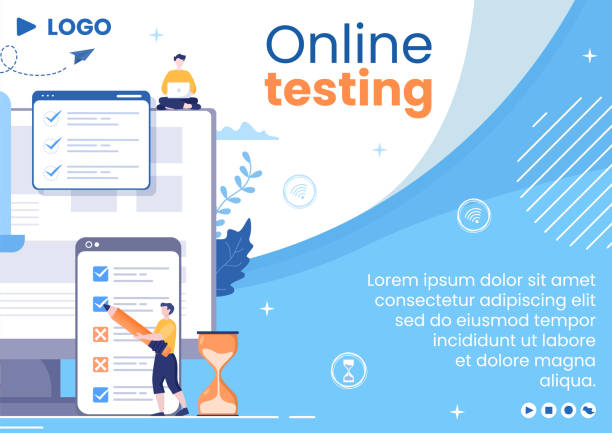Introduction to Responsive Website Design and Its Importance in the Digital Age

In today’s world, where technology is advancing at an incredible pace, an effective online presence is vital for any business.
One of the most important pillars of this presence is #responsive website design.
This advanced approach allows your website to be displayed optimally on any device, from smartphones and tablets to laptops and large desktop monitors.
The importance of #responsiveness lies in the fact that today’s users access the internet from various devices and expect a seamless and flawless user experience.
If your website cannot adapt to this diversity, you might lose a large audience.
This approach not only improves user experience but also plays a key role in search engine optimization (SEO).
Google and other search engines prefer websites that are optimized for mobile, which means you will have a higher ranking in search results.
This explains why addressing this important topic is necessary.
Tired of your company’s website not being seen as it deserves, losing potential customers? Solve this problem forever with professional and effective website design by Rasaweb!
✅ Increase brand credibility and gain customer trust
✅ Attract targeted sales leads
⚡ Contact us now for a free consultation!
Why Responsiveness is Key to Your User Experience and Website SEO?

Thought-provoking content: Have you ever wondered why some websites look great on your phone, while others require endless zooming and scrolling to view? The answer lies in the concept of responsive website design.
Responsive Web Design is not just an extra feature; it’s an absolute necessity for any online business aiming for long-term success.
Analysis: With the increasing use of mobile devices to access the internet, search engines like Google have made mobile optimization one of the most crucial ranking factors.
A website that is not responsive not only provides a poor user experience but also faces issues in SEO rankings.
This means losing traffic, potential customers, and ultimately, business opportunities.
Google’s Mobile-Friendly Tools clearly emphasize the importance of this.
Responsive optimization means your website loads quickly and efficiently, fonts are readable, images are scaled correctly, and navigation is easy, regardless of screen size.
This not only satisfies the user but also sends positive signals to search engines, increasing your site’s credibility and visibility.
Technical Principles and Main Elements of Responsive Website Design

Technical: Responsive website design is built upon three main technical principles: Fluid Grids, Flexible Images, and CSS Media Queries.
Fluid grids mean that instead of using fixed pixel widths, percentages are used so that the website layout can dynamically change with the screen size.
Flexible images, using CSS properties like `max-width: 100%`, ensure that images never exceed their container and are scaled correctly.
Educational: Media Queries form the core of responsive design.
These queries allow developers to apply different CSS rules based on device characteristics such as screen width, orientation (portrait or landscape), and even resolution.
For example, you can define one set of styles for mobile devices with a width less than 768 pixels and another set for desktops.
In addition, a comparative table of key features in responsive and non-responsive design is provided below to better understand the differences and advantages of the responsive approach:
| Feature | Responsive Design | Non-Responsive Design |
|---|---|---|
| Device Compatibility | Excellent (adjusts automatically) | Poor (requires zooming and scrolling) |
| User Experience | Very Good (easy to use at any size) | Frustrating (difficult navigation) |
| SEO Impact | Positive (Google mobile-friendly) | Negative (ranking drop on mobile) |
| Maintenance Cost | Lower (one codebase for all devices) | Higher (requires separate versions) |
Understanding these principles is crucial for anyone intending to work in responsive website design.
Popular Tools and Frameworks for Responsive Implementation

Guidance: To effectively implement responsive website design, web developers use various tools and frameworks that simplify and streamline the process.
One of the most well-known and widely used frameworks is Bootstrap.
Bootstrap is a free and open-source CSS, HTML, and JavaScript framework that helps build responsive and mobile-friendly websites.
This framework includes design templates for typography, forms, buttons, navigation, and other UI components, allowing developers to quickly create responsive designs with minimal coding.
Technical: Another popular framework is Foundation.
Foundation is also an advanced and flexible front-end framework used for building responsive websites and web applications.
This framework is slightly more complex than Bootstrap but offers more flexibility for developers to create fully custom designs.
In addition to these frameworks, using CSS preprocessors like Sass and Less can also help manage and organize CSS codes better in responsive projects.
These tools provide variables, functions, and other capabilities, enabling cleaner and more maintainable coding.
Finally, browser responsiveness testing tools like Chrome’s Developer Tools are essential for testing and debugging layouts across various screen sizes.
Does your company’s website perform as befits your brand? In today’s competitive world, your website is your most important online tool. Rasaweb, specializing in professional corporate website design, helps you to:
✅ Build credibility and customer trust
✅ Convert website visitors into customers
⚡ Get a free consultation!
Impact of Responsive Design on Conversion Rate and Online Business Success

Analysis: Responsive design is not limited to visual aesthetics and technical compatibility; it has a direct and significant impact on the Conversion Rate and ultimately, the success of an online business.
When users receive a seamless and enjoyable user experience on your website, regardless of the device they use, they are more likely to convert into customers.
A non-responsive site that is difficult to use on mobile can have a high Bounce Rate, as users quickly become frustrated and leave.
This user abandonment means losing sales opportunities, leads, and valuable interactions.
News: According to recent statistics and reports, a significant portion of web traffic comes from mobile devices, and this trend continues to rise.
Large companies like Amazon and eBay, by investing heavily in responsive website design, have not only improved their customer experience but have also seen a significant increase in sales and customer loyalty.
This indicates that investing in responsive design is a smart investment with a high return on investment.
From a business perspective, a responsive website means wider audience reach, reduced maintenance costs (as there’s no need to develop multiple versions of the site for different devices), and ultimately, increased profitability.
This approach helps businesses gain a significant competitive advantage in today’s competitive market.
Common Challenges and Solutions in Responsive Website Development

Guidance: Developing a responsive website, despite its many advantages, is not without challenges.
One of the most common challenges is content and image management.
High-quality images suitable for desktop displays may cause slow loading on mobile devices.
The solution to this problem is using `srcset` and `sizes` in HTML for images, or employing lazy loading techniques so that images are only loaded when the user needs them.
Technical: Another challenge is designing navigation for small devices.
Large desktop menus must be converted into a compact and accessible format on mobile, typically as Hamburger Menus.
Ensuring the correct functioning of forms and buttons on touchscreens is also very important.
To solve this problem, precise testing and a “Mobile-First” design approach are needed, where the layout is first designed for the smallest screen and then expanded towards larger screens.
Managing JavaScript scripts and plugins can also be challenging, as some of them may not work correctly on mobile devices or may cause performance degradation.
Careful selection of plugins and optimized coding for mobile are essential.
Finally, continuous testing on various devices and simulators to identify and fix potential issues is a crucial step in the development process.
Best Practices for Responsive UI/UX Design and Image Optimization

Educational: Responsive UI/UX design goes beyond adjusting element dimensions; this approach means providing an unparalleled user experience on any screen size.
One of the best practices is the “Mobile-First” approach.
Instead of designing for desktop and then trying to adapt it for mobile, first design the user experience for the smallest screen, and then gradually expand it for larger screens.
This ensures that the core content and functionality are preserved across all devices.
Guidance: In the field of image optimization, which is one of the most important factors affecting site loading speed on different devices, the use of modern image formats like WebP and AVIF instead of JPEG or PNG is recommended.
These formats offer better compression without a noticeable reduction in image quality.
Furthermore, using the `srcset` and `sizes` attributes in the HTML `` tag allows the browser to load the most appropriate image size for the user’s device, which both increases speed and reduces data consumption.
Here is a table comparing image formats and their applications in responsive UI/UX design:
| Image Format | Advantages | Disadvantages | Recommendation in Responsive Design |
|---|---|---|---|
| JPEG | Wide support, good for photos | Lossy compression, no transparency | Only if necessary, with compression optimization |
| PNG | High quality, supports transparency | Larger file size than JPEG | For icons and graphics with transparency |
| WebP | Excellent compression, supports transparency, animated images | Older browser support | Highly recommended, with fallback for older browsers |
| AVIF | Superb compression, high quality | Newer support, requires specific tools | Recommended for maximum optimization, with fallback |
| SVG | Vector graphics, infinite scalability, small size | Only for vector graphics (logos, icons) | Excellent for logos and icons |
Employing these practices in responsive website design not only improves loading speed but also elevates the user experience to its peak.
Future Trends in Web Design and the Evolution of Responsiveness

News: The world of web design is constantly changing, and responsiveness is no exception.
While the core principles of responsive website design have remained constant, new methods and tools are emerging to improve and evolve it.
One significant trend is the increasing focus on performance and loading speed (Core Web Vitals).
With Google’s emphasis on these vital metrics, developers are seeking solutions to provide a fast and smooth experience even on weak networks and older devices.
This includes using techniques like Progressive Web Apps (PWAs), which bring native app functionalities to websites, and advanced optimizations for CSS and JavaScript.
Analysis: Another trend is Content-Out Design.
Instead of designing the layout first and then fitting content into it, we take content as the starting point and shape the design based on it.
This approach is particularly useful in responsive design, as it ensures that content is displayed correctly and legibly at any size.
Furthermore, with the advent of new devices such as smartwatches, wearables, and even curved displays, the concept of responsiveness is expanding beyond just screen size to include Environmental Adaptation and Sensory Interactions.
This means the future of responsive website design will be very exciting and full of new innovations.
Worried about losing customers because you don’t have a professional e-commerce site?
Forget these worries with e-commerce website design by Rasaweb!
✅ Significant increase in sales and conversion rate from visitor to customer
✅ Professional and user-friendly design that gains customer trust
⚡ Get a free consultation from Rasaweb
Why Your Site Needs Responsive Design? Answers to Frequently Asked Questions

Thought-provoking content: Many business owners might wonder if investing in responsive website design is truly necessary? Or if having a separate Mobile-Specific Website isn’t enough? The unequivocal answer is yes, your website definitely needs responsiveness.
Firstly, having a single, responsive site means simpler management.
Instead of updating two separate versions of the website (one for desktop and one for mobile), you have only one codebase that works for all devices.
This leads to reduced maintenance and development costs.
Explanation: Secondly, from an SEO perspective, Google has explicitly stated that it recognizes responsive websites as the preferred option for mobile-friendliness.
This means that responsive sites are more likely to appear higher in mobile search results.
This translates to increased visibility, traffic, and ultimately, more customers for your business.
Furthermore, the seamless and uninterrupted user experience provided by responsive design increases customer satisfaction and reduces bounce rates.
Today’s users have high expectations, and if your site doesn’t display well on their device, they will quickly turn to your competitors.
Therefore, having a responsive website is no longer an option but a necessity to remain competitive in today’s digital market.
Practical Steps for Converting an Old Site to Responsive and Final Considerations

Guidance: Converting an old, non-responsive website into a responsive one can be a major project, but with proper planning and practical steps, it is entirely feasible.
The first step is a comprehensive analysis of the site’s current status.
Identify sections that require fundamental changes, such as fixed-pixel layouts, fixed-size images, and mobile-unfriendly navigation.
Educational: The next step is to create a flexible layout using fluid grids and media queries.
This may involve rewriting parts of the CSS and HTML.
Then, you must optimize images and videos.
As previously mentioned, using `srcset` and `sizes` attributes for images, as well as optimizing videos for faster loading on different devices, is crucial.
Another important step is redesigning navigation for mobile.
Hamburger menus or similar options can save screen space and make navigation easier on small devices.
Finally, extensive testing and validation across various devices and browsers are essential.
Using online responsive testing tools, browser simulators, and even physical testing on real devices can help identify and resolve issues.
In this process, you may need the assistance of web developers specializing in responsive website design to ensure a smooth and successful transition.
This is an investment that will yield significant returns in improving user experience and SEO rankings.
Frequently Asked Questions
| Question | Answer |
|---|---|
| What is responsive website design? | A web design approach that automatically adjusts and optimizes the layout and content of a site for display on various devices (mobile, tablet, desktop). |
| Why is responsive design important? | Due to the variety of devices users employ to access the web; better user experience, stronger SEO, and reduced user bounce rates are among its advantages. |
| What are the main techniques in responsive design? | Using Media Queries in CSS, Fluid Grids, and Flexible Images. |
| What is a Media Query? | A CSS rule that allows you to apply different styles based on device characteristics (such as screen width, height, and orientation). |
| Is responsive design different from Mobile-First design? | Mobile-First is an approach within responsive design where the site is initially designed for the smallest screen (mobile) and then gradually improved for larger screens. |
And other services of Rasaweb Advertising Agency in the field of advertising
The role of color theory in designing website advertisements
How to use auction websites for ad placement
Ad placement strategies for new salon equipment
The role of website user experience in ad success
How to use pop-up ads for salon equipment
And over hundreds of other services in the field of internet advertising, advertising consulting, and organizational solutions
Internet Advertising | Advertising Strategy | Advertorials
🚀 Revolutionize your business’s digital transformation with Rasaweb’s internet advertising and advertorial strategies.
📍 Tehran, Mirdamad Street, next to Bank Markazi, Kazeroon Jonubi Alley, Ramin Alley, No. 6



